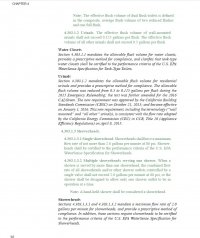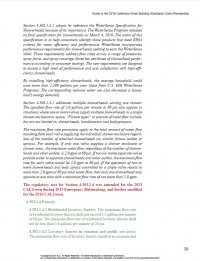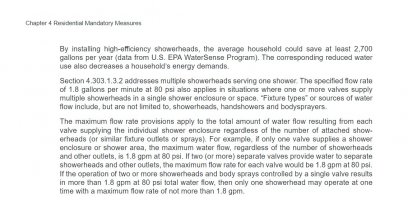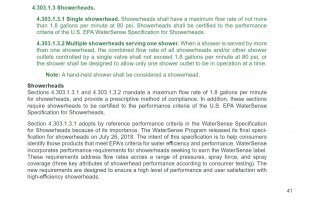California Plumbing Code:
I can't access the CALGreen standard, so I can't quote division 5.3. The plumbing code seems pretty clear: You can have multiple shower heads all operated by a single control valve if the combined flow doesn't exceed 1.8 GPM. You can have two shower heads and two valves if the two valves are somehow interlocked so that you can't operate both showerheads simultaneously.
xx
Division 5.3 has the exact same text as what you quoted. I found in an older document,
Guide to the 2016 California Green Building Code Standard, published by the state, guidance which says each valve in a shower can have the max flow rate (at the time it was 2.0 GPM). The language of the earlier standard is exactly the same, except for the change from 2.0 GPM to 1.8 GPM. But I can't find anywhere that says to interpret it this way still. [bold type mine for emphasis]
"Section 4.303.1.3.2 addresses multiple showerheads serving one shower.
The specified flow rate of 2.0 gallons per minute at 80 psi also applies in
situations where one or more valves supply multiple showerheads in a single
shower enclosure or space. “Fixture types” or sources of water flow include,
but are not limited to, showerheads, handshowers and bodysprayers.
The maximum flow rate provisions apply to the total amount of water flow
resulting from each valve supplying the individual shower enclosure regardless
of the number of attached showerheads (or similar fixture outlets or
sprays). For example, if only one valve supplies a shower enclosure or
shower area , the maximum water flow, regardless of the number of showerheads
and other outlets, is 2.0 gpm at 80 psi.
If two (or more) separate valves
provide water to separate showerheads and other outlets, the maximum flow
rate for each valve would be 2.0 gpm at 80 psi. If the operation of two or
more showerheads and body sprays controlled by a single valve results in
more than 2.0 gpm at 80 psi total water flow, then only one showerhead may
operate at one time with a maximum flow rate of not more than 2.0 gpm."








